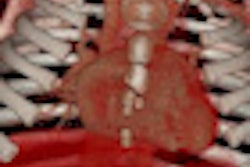
WASHINGTON (Reuters), Mar 3 - Children as young as 13 who have evidence of secondhand smoke in their blood also have visibly thicker arteries, Finnish researchers reported on Tuesday.
Their study suggests that the damage caused by secondhand tobacco smoke starts in childhood and causes measurable damage by the teen years.
"Although previous research has found that passive smoke may be harmful for blood vessels among adults, we did not know until this study that these specific effects also happen among children and adolescents," Dr. Katariina Kallio of the University of Turku in Finland, who led the study, said in a statement.
Her team studied 494 children ages 8 to 13 taking part in ongoing research on heart disease. They measured levels of cotinine, a byproduct of nicotine that is found in the blood after someone breathes in tobacco smoke.
They divided the children into groups with high, intermediate, and low cotinine levels. Ultrasound was used to measure the thickness of the aorta and of the carotid artery in the neck.
Artery walls look thicker on an ultrasound if they are damaged by the process of atherosclerosis.
The children with the most cotinine in their blood had carotid artery walls that were, on average, 7% thicker than the children with the lowest cotinine levels, Kallio's team reported in the journal Circulation: Cardiovascular Quality and Outcomes. Their aortas were 8% thicker.
The researchers also did a test that measures the flexibility of the arteries in the arm, another measure of blood vessel health and heart disease risk.
This measurement, called brachial artery flow-mediated dilation, was 15% lower in teenagers with the highest levels of cotinine, they found.
And measures of cholesterol showed unhealthier levels among the children with more smoke in their blood.
"These findings suggest that children should not face exposure to tobacco smoke at all," Kallio said. "Even a little exposure to tobacco smoke may be harmful for blood vessels."
In October, the U.S. Institute of Medicine reported that indoor smoking bans lower the risk of heart attack even among nonsmokers by reducing exposure to secondhand smoke.
The U.S. Centers for Disease Control and Prevention and the American Heart Association say secondhand smoke kills an estimated 46,000 Americans from heart disease every year.
The World Lung Foundation and the American Cancer Society jointly project that tobacco use will kill 6 million people next year from cancer, heart disease, emphysema, and other ills, with direct medical costs to the global economy of $500 billion a year.
In their cancer atlas -- available at http://www.tobaccoatlas.org/ -- the groups say that 1 billion men and 250 million women globally smoke daily.
Source: Circulation: Cardiovascular Quality and Outcomes, online March 2, 2010.
Last Updated: 2010-03-02 16:56:23 -0400 (Reuters Health)
Related Reading
Helium diffusion MRI shows early view of secondhand smoke lung damage, November 26, 2007
Copyright © 2010 Reuters Limited. All rights reserved. Republication or redistribution of Reuters content, including by framing or similar means, is expressly prohibited without the prior written consent of Reuters. Reuters shall not be liable for any errors or delays in the content, or for any actions taken in reliance thereon. Reuters and the Reuters sphere logo are registered trademarks and trademarks of the Reuters group of companies around the world.


















